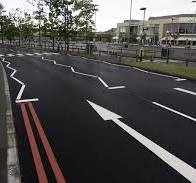Understanding the Importance of Zig Zag Road Markings in the UK

The Importance of Zig Zag Road Markings
Zig zag road markings are a familiar sight on roads around the world, including in the United Kingdom. These distinctive markings play a crucial role in ensuring road safety and traffic flow, particularly near pedestrian crossings and other high-risk areas.
What Are Zig Zag Road Markings?
Zig zag road markings consist of a series of diagonal lines painted on the road surface. These markings are typically found near pedestrian crossings, such as zebra crossings and pelican crossings. The zig zag pattern serves as a visual warning to drivers, indicating areas where parking or overtaking is prohibited.
The Purpose of Zig Zag Road Markings
The primary purpose of zig zag road markings is to create a clear and unobstructed zone around pedestrian crossings. By prohibiting parking or overtaking in these areas, zig zag markings help to maintain visibility for both pedestrians and drivers approaching the crossing.
Furthermore, the presence of zig zag road markings alerts drivers to the potential presence of pedestrians crossing the road. This visual cue serves as a reminder to motorists to slow down, exercise caution, and be prepared to stop if necessary.
Compliance with Regulations
In the United Kingdom, the use of zig zag road markings is governed by strict regulations outlined in the Highway Code. It is illegal for drivers to park on or over these markings, except in certain circumstances specified by law.
Local authorities are responsible for maintaining zig zag road markings and ensuring their visibility and effectiveness. Failure to comply with these regulations can result in fines or penalties for motorists who disregard the restrictions imposed by zig zag markings.
Conclusion
In conclusion, zig zag road markings play a vital role in promoting road safety and protecting pedestrians at designated crossing points. By obeying these markings and respecting the restrictions they impose, motorists can contribute to creating safer roads for everyone.
Understanding Zig-Zag Road Markings: FAQs on Types, Meanings, and Parking Rules
- What are the four types of road markings?
- Can I stop on white zig-zag lines?
- What does yellow zig-zag on road mean?
- Can you park on zig-zag lines?
- What are the 4 types of road markings?
What are the four types of road markings?
One frequently asked question regarding road markings is, “What are the four types of road markings?” The four main types of road markings include longitudinal markings, transverse markings, delineator markings, and object marking. Longitudinal markings run parallel to the direction of traffic flow and are typically used to guide drivers along the road. Transverse markings are perpendicular to the direction of traffic and serve various purposes such as indicating stop lines, pedestrian crossings, and give way lines. Delineator markings help define the edges of lanes or roads, providing visual cues to drivers to maintain their position on the road. Object marking involves marking physical objects on or near the road, such as bollards or barriers, to enhance visibility and safety for road users. Understanding these different types of road markings is essential for promoting safe and efficient traffic flow on roads.
Can I stop on white zig-zag lines?
One frequently asked question regarding zig zag road markings is, “Can I stop on white zig-zag lines?” In the United Kingdom, it is illegal to stop on white zig-zag lines. These markings are placed near pedestrian crossings to ensure clear visibility and safety for pedestrians crossing the road. Stopping on zig-zag lines is strictly prohibited by law, as it obstructs the view for both pedestrians and drivers, increasing the risk of accidents. Motorists should always adhere to road regulations and avoid stopping or parking on white zig-zag lines to maintain road safety and prevent potential penalties or fines.
What does yellow zig-zag on road mean?
The yellow zig-zag road markings hold significant importance in traffic regulations. These markings indicate areas where parking is strictly prohibited. The presence of yellow zig-zag lines near pedestrian crossings signifies that drivers are not allowed to park or overtake in those zones. This restriction aims to ensure clear visibility for both pedestrians and motorists approaching the crossing, enhancing safety on the road. It is essential for drivers to adhere to these markings to maintain traffic flow and prioritise pedestrian safety at designated crossing points.
Can you park on zig-zag lines?
One of the frequently asked questions regarding zig zag road markings is whether it is permissible to park on zig-zag lines. In the United Kingdom, it is illegal to park on or over zig-zag lines, as these markings indicate areas where parking is strictly prohibited. Zig-zag lines are typically found near pedestrian crossings and serve to ensure clear visibility for both pedestrians and drivers approaching the crossing. Parking on zig-zag lines not only obstructs traffic flow but also poses a safety hazard by reducing visibility and increasing the risk of accidents. Motorists are advised to adhere to road regulations and respect the restrictions imposed by zig-zag markings to maintain road safety for all road users.
What are the 4 types of road markings?
One frequently asked question regarding road markings is, “What are the 4 types of road markings?” Road markings can be categorised into four main types: longitudinal markings, transverse markings, object markings, and special markings. Longitudinal markings run parallel to the direction of traffic flow and include lane lines, centre lines, and edge lines. Transverse markings are perpendicular to the direction of travel and include stop lines, pedestrian crossings, and symbols like arrows. Object markings highlight physical hazards or delineate areas such as bollards or kerbs. Special markings encompass unique designs for specific purposes, such as bus lanes or cycle lanes. Understanding these different types of road markings is essential for promoting road safety and efficient traffic management.
